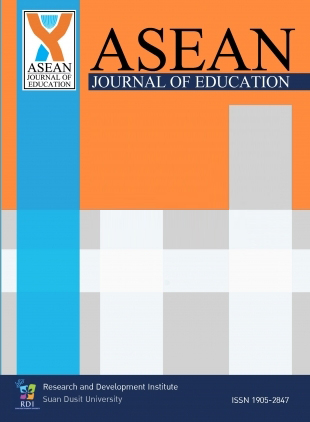Technological Capabilities of Teachers in Using Digital Modality
关键词:
Capability, Competencies, Digital modality, JASP software, Technology education摘要
The pandemic reminds every teacher that everything must be done as quickly as possible to respond to every challenge and new development in the teaching process. In addition, it is necessary to recognize how to engage with students and deliver efficient and effective instruction. This study aims to assess teacher's technological capability in the use of digital modality in the classroom. Purposive sampling was used in the quantitative study, and 62 teachers participated in the study. The data was analyzed using JASP software. The study researched the level of technological capabilities of the teachers and its relationships between technological capability levels and teachers' age, teaching experience, and educational attainment. The results show that technological capabilities of teachers were “Distinguished”. It implies that young teachers have higher technological capabilities than older teachers. However, since age has a significant relationship with technological capability, it may be used as a basis of intervention. This study can be used as baseline information for the teachers upskilling and retooling technological capabilities. As teachers extend their service and increase in age additional technology training should be provided.
参考
Arrieta, G. S., Calabio, R. C., & Rogel, E. M. (2020). Accompanying Students in Online Learning: Challenges and Interventions. Jurnal Inovatif Ilmu Pendidikan, 2(2), 106-119.
Arrieta, G. S. (2020). The Experiences Of Junior High School Teachers In Online Teaching And Learning During Enhanced Community Quarantine: Inputs For The Learning Continuity Plan For The New Normal In Education. Jayapangus Press
Books, 383-404. Azhar, K. A., & Iqbal, N. (2018). Effectiveness of Google classroom: Teachers’ perceptions. Prizren Social Science Journal, 2(2), 52.
Batac, K. I. T., Baquiran, J. A., & Agaton, C. B. (2021). Qualitative Content Analysis of Teachers’ Perceptions and Experiences in Using Blended Learning during the COVID-19 Pandemic. International Journal of Learning, Teaching and Educational Research, 20(6), 225–243. https://doi.org/10.26803/ijlter.20.6.12
De Vera, J. L., Andrada, M. D., Bello, A., & De Vera, M. G. (2021). Teachers' Competencies in Educational Technology Integration on Instructional Methodologies in the New Normal. Lukad: An Online Journal of Pedagogy, 1(1), 61-80.
De Vera, J. L. (2020). Challenges and Teacher Resilience: The New Normal Classroom Instruction Using Social Media in Philippine Context. Available at SSRN, 3760369.
Fahrman, B., Norström, P., Gumaelius, L., & Skogh, I. B. (2019). Experienced technology teachers’ teaching practices. International Journal of Technology and Design Education, 30(1), 163–186. https://doi.org/10.1007/s10798-019-09494-9
Han, H., & Dawson, K. J. (2020). JASP (software). Iftakhar, S. (2016). Google classroom: what works and how. Journal of Education and Social Sciences, 3(1), 12-18.
Javier, C. (2020). The shift towards new teaching modality: Examining the attitude and technological competence among language teachers teaching Filipino. Asian ESP, 16(2.1), 210-244.
Masry-Herzalah, A., & Dor-Haim, P. (2021). Teachers’ technological competence and success in online teaching during the COVID-19 crisis: The moderating role of resistance to change. International Journal of Educational Management.
Omair, A. (2015). Selecting the appropriate study design for your research: Descriptive study designs. Journal of health specialties, 3(3), 153.
Rao, Y. S., Ramesh, M. A., & Vandana, V. V. (2019). A Study on Faculty Perspectives on Ict Integration in Teaching Learning Process. International Academic Journal of Business Management, 6(1), 68–75. https://doi.org/10.9756/iajbm/v6i1/1910009
Ritz, J. (2017). Technology Teacher Education. Encyclopedia of Earth Sciences Series, 1–3. https://doi.org/10.1007/978-3-319-38889-2_72-1
Siemens, G. (2005). Connectivism: A learning theory for the digital age. International Journal of Instructional Technology and Distance Learning, 2(1). Retrieved from http://www.itdl.org/
Slomanson, W. R. (2014, January 18). Blended Learning: A Flipped Classroom Experiment.Retrieved from https://papers.ssrn.com/sol3/papers.cfm?abstract_id=2381282
Tupas, F. P., & Linas-Laguda, M. (2020). Blended Learning – An Approach in Philippine Basic Education Curriculum in New Normal: A Review of Current Literature. Universal Journal of Educational Research, 8(11), 5505–5512. https://doi.org/10.13189/ujer.2020.081154
Ventayen, R. J. M., Salcedo, R., Orlanda-Ventayen, C. C., Ventayen, L. M., & Ventayen, T. J. M. (2019). Senior High School Teachers’ Practices and Readiness in Blended Learning Environment: Basis for a Blended Learning Preparedness Framework. SSRN Electronic Journal, 9(2). https://doi.org/10.2139/ssrn.3504189
Xu, M., Williams, P. J., Gu, J., Liu, M., & Hong, J. C. (2021). Technology teachers’ professional attitudes towards technology: An investigation of Chinese high school general technology teachers. International Journal of Technology and Design Education, 32, 2111–2127. https://doi.org/10.1007/s10798-021-09686-2
##submission.downloads##
已出版
##submission.howToCite##
期
栏目
##submission.license##
##submission.license.cc.by-nc-nd4.footer##1 All articles will undergo a formal peer-review. A panel of experts from within or without the university will examine the article; approval from a minimum of two experts is required for publication. Revisions posed by the experts must be completed by the research prior to publication.
2 Once published in the ASEAN Journal of Education, the article becomes intellectual property of Suan Dusit University. Duplication, in full or part, requires permission from Suan Dusit University.
3 Excluding errors incurred during printing, author(s) are responsible for the content of their articles.






